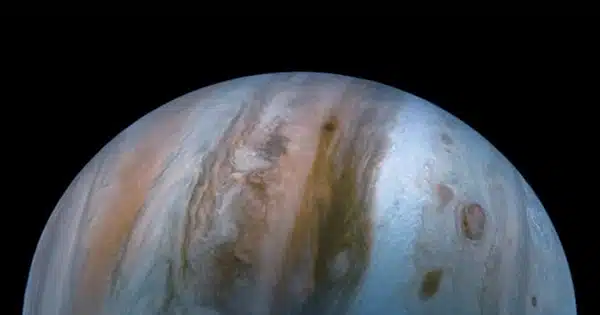Scientists have typically looked for planets with liquid water on their surface when searching for life in the universe. However, a lot of a planet’s water may be trapped in rocks deep within its interior rather than flowing as seas and rivers.
Now that they have a method, researchers from the University of Cambridge can determine how much water a rocky world can hold in its underground reservoirs. Deep within the structure of minerals, there is water that may help a planet recoup from its fiery birth, according to some theories.
The scientists created a formula that can forecast how many water-rich minerals are present on a planet. These minerals function as a kind of sponge, soaking up water that later resurfaces and replenishes the seas. Their findings may aid in our understanding of how worlds that have experienced extreme heat and radiation in their early years can eventually become habitable.
One of the best locations to search for extraterrestrial life is on planets that orbit M-type red dwarf stars, which are the most prevalent stars in the galaxy. However, during their turbulent adolescence, these stars produce powerful radiation blasts that blast neighboring planets and bake off their surface water.

Our sun’s adolescent era was brief, whereas red dwarf stars spend a lot more time going through this difficult transition. As a consequence, the planets under their care experience a runaway greenhouse effect that disrupts the climate.
Claire Guimond, a Ph.D. candidate in Cambridge’s Department of Earth Sciences, is the study’s main author. “We wanted to explore whether these planets, after such a turbulent upbringing, could rehabilitate themselves and go on to host surface water,” she said.
After a planet’s host star has grown older and dimmed, a new study published in the Monthly Notices of the Royal Astronomical Society suggests that interior water may be a practical means to replenish liquid surface water. This water, along with other elements that are essential for life, was probably carried to the surface of the earth by volcanoes and slowly released as steam into the atmosphere.
They can now determine a planet’s interior water capacity based on its size and the makeup of its host star thanks to their novel model. Based on these minerals and their capacity to incorporate water into their structures, the model “gives us an upper limit on how much water a planet could transport at depth,” said Guimond.
The amount of water that a planet can contain depends largely on its size, the researchers discovered. This is because the percentage of water-carrying minerals that make up a planet depends on its size.
The upper mantle, a stratum of rocks beneath the crust, is where the majority of a planet’s interior water is found. Here, pressure and temperature conditions are ideal for the creation of the green-blue, water-sopping minerals wadsleyite and ringwoodite. Volcanoes that are close by and could erupt there could also bring water back to the top through this rocky layer.
According to the latest findings, larger planets—those that are two to three times as massive as Earth—typically have rocky mantles that are drier because their water-rich upper mantles make up a lower percentage of their overall mass.
The findings may offer scientists direction in their hunt for exoplanets that may harbor life. Oliver Shorttle, a joint affiliate of Cambridge’s Department of Earth Sciences and Institute of Astronomy, said that this could help improve our triage of which planets to investigate first. “You probably don’t want one that is significantly more massive or wildly smaller than Earth when we’re searching for the planets that can hold water best,” says the researcher.
The discoveries might also deepen our comprehension of how planets, including those nearer to us like Venus, can change from an arid wasteland to a blue crystal. Venus, which is comparable to Earth in size and bulk composition, has a surface temperature of about 450°C and a dense atmosphere of carbon dioxide and nitrogen. Whether Venus had flowing water on its surface 4 billion years ago is still up for debate.
If that is the case, Shorttle explained, “Venus must have discovered a way to cool itself and regain surface water after being born around a fiery sun. It’s conceivable that it tapped into its interior water to do this.















